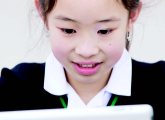Ever since I founded the MirandaNet Fellowship in 1992 our community has been expecting a revolution in teaching and learning because of the impact of digital technologies in schools. Over the years we have grown from fifteen teachers in England who saw themselves as thought leaders in education innovation to one thousand members in eighty countries. Our online and face to face debates and our members’ publications on our website indicate that the exponential increase in the use of technology is a global phenomenon.
Our hopes for a revolution on teaching and learning strengthened in 1997 when the UK government introduced the National Learning Grid: the first internet service for education in the world. However, unlike the workplace that has been transformed by technology, most classrooms have continued to look much the same for the last 100 years.
MirandaNet Fellows investigated the reasons for the slow pace of change about five years ago. The teachers who were interviewed had been nominated by their peers as excellent practitioners. These professionals were often able to use the desktop computers at home but were reluctant to use them in the classroom.
We found they had good reasons. They questioned the design of some learning products: inappropriate loud sounds and tasteless animations diminished the calm atmosphere of learning they were trying to create. They found that internet access was not always reliable and that, when computers in network rooms did not work, the rhythm of the lesson was interrupted.
Overall these reluctant teachers were sensitive about gimmickry and about money being spent on technologies for their ‘wow’ appeal rather than because their educational value was proven. These were fair professional judgments – but they were mostly focused on the challenges of the network room and the software available there.
In their hands
Now a tipping point has been reached in education innovation. Why? Well, for the last twenty years keeping the school networks and computer rooms functioning has absorbed staff energy, consumed money and put control in the hands of the network manager. In contrast Fellows are now observing a sudden change in practice because personal tablets and smart phones have put powerful and affordable tools in teachers’ personal control, 24/7. Now that this technology is smoother, faster and more intuitive, the uses in everyday life have stimulated a much wider professional understanding about how this technology might be used in the classroom and at home.
David Fuller, a MirandaNet Fellow, has published an action research study about the use of tablets at Fonthill Foundation schools in Brighton. When tablets were first purchased, David worked closely with the teachers to translate the potential of a tablet into classroom practice. He also harnessed the students’ empathy with this technology – a valuable source of insight for teachers. David advocates allowing students to experiment, share and, most importantly, to reflect on the potential the technology offers the pupils. For example he describes students writing their own books: “For the final section of the lesson, they passed on their book to a colleague who completed audio or video feedback on what they thought about their book for the author. This proved really useful encouragement for the SEN children who attended the session”.
Taking time
In the Fonthill schools new kinds of learning are taking place, whereas at Warden Park School in West Sussex, Dai Thomas, another MirandaNet Fellow, has planned a slow revolution in learning through well-organised trials of tablets. His study emphasises an emerging pedagogical practice called Flipped Learning (see also pages 35-35 of this issue). The idea is to ‘flip’ the responsibility of learning to pupils so that the teacher becomes more of a facilitator. This model explores a different way of using physical and virtual space from traditional approaches: students are encouraged to research a topic outside the classroom now that they have significant resources at their finger-tips through safe use of the internet. Students also view instructional videos at home and then debate what they have learnt at school where the teacher can pick up the misconceptions and encourage inspiration. Students return to the classroom to collaborate, coach, and instruct each other and debate with their peers and their teachers. Tablet technology also underpins the opportunity for small groups or individuals to present strategies and solutions to help others. Enthusiasts maintain that students’ understanding is internalised and reinforced.
Dai’s study indicates that clear leadership is essential to make flipped learning work and anticipate challenges. Reasonable reflection time and professional development space is also important but because teachers do have to change their teaching style from information transmission. Some advice that emerges from the first eighteen months of this project is:
- Help teachers view positively the move to use tablets by starting with personal administrative tasks: for example registration and email on the move; note taking; and resource collection.
- Encourage teachers to enlist pupils to help them as pupils welcome opportunities to help the teachers understand the tablets
- Debate the wider and broader aims of education within the staff. At some point the whole staff will want to consider whether they are willing to adjust the theoretical underpinning that informs their professional life and adjust school policies on teaching and learning on the evidence of promoting tablets for all.
- Communicate sympathetically with parents and staff members who are concerned about league tables and academic rigour because the current assessment environment does not encourage the changes in teaching and learning that are pursued in this project.
Of course this revolution in the ownership of personal devices is already causing dissent from some teachers. For example, a research report that is being hotly contested on the debating channel, MirandaLink, appears to prove that in schools where mobile phones are banned achievement scores improve. Even if the methodology is flawed note must be taken. Enthusiastic innovators bringing in mobile devices must work with all the teachers and parents on a code of conduct that everyone can sign up to.
Professor Mike Sharples summed up the overall MirandaLink consensus that schools have a responsibility to harness the power of mobile devices for learning. “This is just one small way to help students ‘navigate life’ and develop valued and transferrable skills. The key is not to let devices rule in school, but to put them into their proper place alongside the other equipment for learning, and to encourage responsible and safe use”.
Perhaps not a revolution then, but rather, thoughtful changes in practice designed to prepare pupils for the future.
ABOUT THE AUTHOR
Christina Preston is the 95 founder of The Mirandanet Fellowship; a community of practice that is free to join www.mirandanet.ac.uk. MirandaNet associates, Tablet Academy, run course for schools about using tablets creatively in schools (www. mirandanet.ac.uk/associates); and members’ debates can be seen at www.mirandanet.ac.uk/mirandalinkthought- leadership-and-debate










